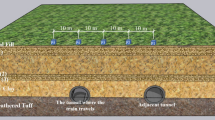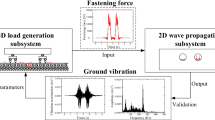Abstract
Environmental vibration and ground-borne noise from light rail transport (LRT) networks consists a major impact on the urban environment. Since experiments are often difficult to obtain and to interpret especially for environmental vibration, designers and researchers generally resource numerical model to assess vibration levels and understand the complex mechanism of generation and propagation of ground vibration. In this paper, some highlights are provided on vehicle/track/soil modeling for railway-induced ground vibration, including the proper definitions of each of these subsystems. The nature of the wheel/rail interaction is also important, especially in urban area, so a case study demonstrates that local unevenness are important sources of vibrations. On the other hand, specialized prediction models and dose-response relationships for airborne rail noise during operation and construction phases of urban light rail transport networks (both underground and surficial) are needed to be evaluated, in order to quantify the impact of the technical characteristics of the noise source, the operation mode with emphasis to speed, the propagation, the implementation of quiet facades, and the number and distribution of high-level noise events. In the present paper, two distinct case studies are presented in order to emphasize the need and the necessity of using proper tools to predict, access, monitor, and evaluate the environmental impact of LRTs to the urban acoustic environment: (a) the new Brussels Regional Express Network and (b) the new Athens Metro Line 3 extension to Piraeus port in an underground tunnel (length 7.6 km).













Similar content being viewed by others
References
Vogiatzis KE. Athens metro extension project to Piraeus ground borne noise and vibration assessment and control. International Journal of Mechanics. 2012;6(2):130–9.
Hussein M. Modelling vibration from surface and underground railways as an evolutionary random process. In: TIZANI W, editor. Computing in civil and building engineering. Proceedings of the International Conference. Nottingham: Nottingham University Press; 2010. p. 551. Paper 276, ISBN 978-1-907284-60-1.
Watts G.R. The Effects of Traffic Induced Vibrations on Heritage Buildings –Further Case Studies. Research Report 207. Transport and Road Research Laboratory. Department of Transport, UK, 1989.
Bigot A, Farroto G. Tunnel boring machine vibration impact prediction method based on surface vibration measurements and tunnel to surface transfer function calculation. 23rd International Congress on Sound and Vibration (ICSV23), 2016;Athens Greece.
Kouroussis G, Connolly DP, Verlinden O. Railway induced ground vibrations—a review of vehicle effects. International Journal of Rail Transportation. 2014a;2(2):69–110. doi:10.1080/23248378.2014.897791.
Knothe K, Grassie SL. Modelling of railway track and vehicle/track interaction at high frequencies. Veh Syst Dyn. 1993;22:209–62.
Auersch L. Theoretical and experimental excitation force spectra for railway-induced ground vibration: vehicle-track-soil interaction, irregularities and soil measurements. Veh Syst Dyn. 2010;48:235–61.
Costa PA, Calçada R, Cardoso AS. Vibrations induced by railway traffic: influence of the mechanical properties of the train on the dynamic excitation mechanism. 8th International Conference on Structural Dynamics: EURODYN 2011, 2011;804–811.
Kouroussis G, Verlinden O, Conti C. On the interest of integrating vehicle dynamics for the ground propagation of vibrations: the case of urban railway traffic. Veh Syst Dyn. 2010;48:1553–71.
Galvín P, François S, Schevenels M, Bongini E, Degrande G, Lombaert G. A 2.5D coupled FE-BE model for the prediction of railway induced vibrations soil. Dynamics and Earthquake Engineering. 2010;30:1500–12.
Connolly D, Giannopoulos A, Forde MC. Numerical modelling of ground borne vibrations from high speed rail lines on embankments. Soil Dyn Earthq Eng. 2013;46:13–9.
Frühe G, Müller G. Dynamic soil--structure interaction applying a hybrid ITM/FEM approach. ISMA2010 International Conference on Noise and Vibration Engineering, 2010;3453–3461.
Gardien W, Stuit HG. Modelling of soil vibrations from railway tunnels. J Sound Vib. 2003;267:605–19.
Pyl L, Degrande G, Clouteau D. Validation of a source-receiver model for road traffic induced vibrations in buildings. II: Receiver model ASCE, Journal of Engineering Mechanics. 2004;130:1394–406.
Lombaert G, Degrande G, Kogut J, François S. The experimental validation of a numerical model for the prediction of railway induced vibrations. Journal of Sound and Vibrations. 2006;297:512–35.
Triepaischajonsak N, Thompson DJ, Jones CJC, Ryue J, Priest JA. Ground vibration from trains: experimental parameter characterization and validation of a numerical model. Journal of Rail and Rapid Transit. 2011;225:140–53.
Kouroussis G, Verlinden O. Prediction of railway induced ground vibration through multibody and finite element modelling. Mechanical Sciences. 2013;4:167–83.
Costa PA, Calçada R, Cardoso AS. Influence of train dynamic modelling strategy on the prediction of track-ground vibrations induced by railway traffic. Journal of Rail and Rapid Transit. 2012;226:434–50. doi:10.1177/0954409711433686.
Vogiatzis K, Kouroussis G. Prediction and efficient control of vibration mitigation using floating slabs: practical application at Athens metro lines 2 and 3. International Journal of Rail Transportation. 2015; doi:10.1080/23248378.2015.1076622.
Anastasopoulos I, Alfi S, Gazetas G, Bruni S, Leuven AV. Numerical and experimental assessment of advanced concepts to reduce noise and vibration on urban railway turnouts. J Transp Eng. 2009;135:279–87.
Kouroussis G, Connolly DP, Alexandrou G, Vogiatzis K. The effect of railway local irregularities on ground vibration. Transportation Research - Part D: Transport and Environment. 2015a;39:17–30.
Kouroussis G, Connolly DP, Alexandrou G, Vogiatzis K. Railway ground vibrations induced by wheel and rail singular defects. Veh Syst Dyn. 2015b;53:1500–19.
Talbot JP. Lift-over crossings as a solution to tram-generated ground-borne vibration and re-radiated noise. Journal of Rail and Rapid Transit. 2014;228:878–86.
Connolly DP, Kouroussis G, Giannopoulos A, Verlinden O, Woodward PK, Forde MC. Assessment of railway vibrations using an efficient scoping model. Soil Dyn Earthq Eng. 2014a;58:37–47.
Connolly DP, Kouroussis G, Woodward PK, Verlinden O, Giannopoulos A, Forde MC. Scoping prediction of re-radiated ground-borne noise and vibration near high speed rail lines with variable soils. Soil Dyn Earthq Eng. 2014b;66:78–88.
Verbraken H, Lombaert G, Degrande G. Verification of an empirical prediction method for railway induced vibrations by means of numerical simulations. J Sound Vib. 2011;330:1692–703.
European Parliament Directive 2002/49/EC of the Council of 25 June 2002 relating to the assessment and management of environmental noise. OJ L 189 ed. 2002.
European Commission Directive 2015/996 of 19 May 2015 establishing common noise assessment methods according to Directive 2002/49/EC of the European Parliament and of the Council. OJ of the European Communities ed. 2015.
Carels P, Ophalffens K, Vogiatzis K. Noise and vibration evaluation of a floating slab in direct fixation turnouts in Ηaidari & Αnthoupoli extentions of Athens metro lines 2 & 3 [Valutazione del rumore indotto e delle vibrazioni delle piattaforme flottanti negli scambi con fissaggio diretto posti lungo le estensioni “Haidari & Anthoupoli” delle linee 2 e 3 della metropolitana di Atene]. Ingegneria Ferroviaria. 2012;67(6):533–53.
Vogiatzis K, Vanhonacker P. Noise reduction in urban LRT networks by combining track based solutions. Sci Total Environ. 2016;568:1344–54. doi:10.1016/j.scitotenv.2015.05.060.
Kouroussis G, Connolly D, Forde M, Verlinden O, An experimental study of embankment conditions on high-speed railway ground vibrations. 20th International Congress on Sound and Vibration (ICSV20), 2013a, Bangkok, Thailand.
Kouroussis G, Conti C, Verlinden O. Experimental study of ground vibrations induced by Brussels IC/IR trains in their neighbourhood. Mechanics & Industry. 2013b;14:99–105.
Auersch L. The excitation of ground vibration by rail traffic: theory of vehicle-track-soil interaction and measurements on high-speed lines. J Sound Vib. 2005;284:103–32.
Kouroussis G, Van Parys L, Conti C, Verlinden O. Prediction of ground vibrations induced by urban railway traffic: an analysis of the coupling assumptions between vehicle, track, soil, and buildings. International Journal of Acoustics and Vibration. 2013c;18:163–72.
Kouroussis G, Van Parys L, Conti C, Verlinden O. Using three-dimensional finite element analysis in time domain to model railway—induced ground vibrations. Adv Eng Softw. 2014b;70:63–76.
Kouroussis G, Florentin J, Verlinden O. Ground vibrations induced by InterCity/InterRegion trains: a numerical prediction based on the multibody/finite element modelling approach. J Vib Control. 2016;22:4192–210.
DIN 4150: Parts 1–3: Structural Vibration in Buildings, Effects on Structures; 1986.
Vogiatzis K. Environmental vibration monitoring and assessment at sensitive receptors during Metro construction in urban centre of Thessaloniki, Greece, WSEAS Transactions on Environment and Development. ISSN: 1790–5079 255, 2011;9(7).
Connolly DP, Kouroussis G, Laghrouche O, Ho C, Forde MC. Benchmarking railway vibrations—track, vehicle, ground and building effects. Constr Build Mater. 2015;92:64–81. doi:10.1016/j.conbuildmat.2014.07.042.
Author information
Authors and Affiliations
Corresponding author
Ethics declarations
Conflict of Interest
The authors declare that they have no conflict of interest.
Additional information
This article is part of the Topical Collection on Noise Pollution
Rights and permissions
About this article
Cite this article
Vogiatzis, K.E., Kouroussis, G. Environmental Ground-Borne Noise and Vibration from Urban Light Rail Transportation During Construction and Operation. Curr Pollution Rep 3, 162–173 (2017). https://doi.org/10.1007/s40726-017-0059-3
Published:
Issue Date:
DOI: https://doi.org/10.1007/s40726-017-0059-3




